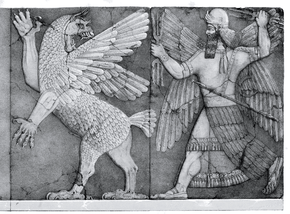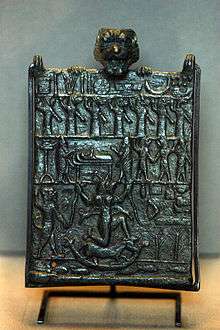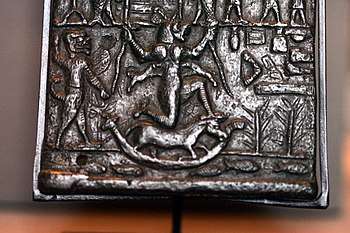Lamashtu
In Mesopotamian mythology, Lamashtu (Akkadian dLa-maš-tu; Sumerian Dimme dDim3-me or Kamadme[2]) was a female demon, monster, malevolent goddess or demigoddess who menaced women during childbirth and, if possible, kidnapped their children while they were breastfeeding. She would gnaw on their bones and suck their blood, as well as being charged with a number of other evil deeds. She was a daughter of the Sky God Anu.
| Part of a series on |
| Ancient Mesopotamian religion |
|---|
 Chaos Monster and Sun God |
|
Seven gods who decree
|
|
Other major deities |
|
Demigods and heroes
|
| Related topics |

Lamashtu is depicted as a mythological hybrid, with a hairy body, a lioness' head with donkey's teeth and ears, long fingers and fingernails, and the feet of a bird with sharp talons. She is often shown standing or kneeling on a donkey, nursing a pig and a dog, and holding snakes. She thus bears some functions and resemblance to the Mesopotamian demon Lilith.
Mythology
Lamashtu's father was the Sky God Anu.[3] Unlike many other usual demonic figures and depictions in Mesopotamian lore, Lamashtu was said to act in malevolence of her own accord, rather than at the gods' instructions. Along with this her name was written together with the cuneiform determinative indicating deity.[4] This means she was a goddess or a demigoddess in her own right.[5]
She bore seven names and was described as seven witches in incantations. Her evil deeds included (but were not limited to): slaying children, unborns, and neonates; causing harm to mothers and expectant mothers; eating men and drinking their blood; disturbing sleep; bringing nightmares; killing foliage; infesting rivers and lakes; and being a bringer of disease, sickness, and death.[5]
Pazuzu, a god or demon, was invoked to protect birthing mothers and infants against Lamashtu's malevolence, usually on amulets and statues. Although Pazuzu was said to be bringer of famine and drought, he was also invoked against evil for protection, and against plague, but he was primarily and popularly invoked against his fierce, malicious rival Lamashtu.[6]
Incantation against Lamaštu:
Great is the daughter of Heaven who tortures babies
Her hand is a net, her embrace is death
She is cruel, raging, angry, predatory
A runner, a thief is the daughter of Heaven
She touches the bellies of women in labor
She pulls out the pregnant women's baby
The daughter of Heaven is one of the Gods, her brothers
With no child of her own.
Her head is a lion's head
Her body is a donkey's body
She roars like a lion
She constantly howls like a demon-dog.[7]
In modern culture
- Lamashtu a demon lord and the goddess of monsters, called the Mother of Beasts and Mistress of Insanity, in the role-playing game setting Pathfinder.
- Lamashtu appears as a character in the NBC television series Constantine in the episode "The Saint of Last Resorts".
- Lamashtu is the title of a 2015 Audiobook by Paul E Cooley.
- Lamashtu appears as an antagonist in the 2018 novel "On Devil's Wings" by M. J. Meade.
- Lamashtu appears as the antagonist in the 2017 film Still/Born.
- Lamashtu appears as the song "lamashtu" by Necrophobic on their 2018 album "Mark of the Necrogram"
- Lamashtu is depicted on the Ankaran Sarcophagus in the videogame Vampire: The Masquerade – Bloodlines
- Lamashtu appears in the book "Sebitti - Mesopotamian Magick & Demonology" by Michael W. Ford Succubus Publishing 2016
- Lamashtu appears as the 2020 album theme of "Scourge of Lamashtu" by Black Funeral Iron Bonehead Productions
Ritual
An Akkadian incantation and ritual against Lamashtu is edited in Texte aus der Umwelt des Alten Testaments vol. 2 (1988)[8] It is glossed as an "incantation to dispel lasting fever and Lamashtu". The prescribed ritual involves a Lamashtu figurine. A sacrifice of bread must be placed before the figurine and water must be poured over it. A black dog must be made to carry the figurine. Then it is placed near the head of the sick child for three days, with the heart of a piglet placed in its mouth. The incantation must be recited three times a day, besides further food sacrifices. At dusk on the third day, the figurine is taken outdoors and buried near the wall.
 Lamashtu plaque held by Pazuzu
Lamashtu plaque held by Pazuzu Close-up of plaque's top register
Close-up of plaque's top register Close-up of plaque's bottom register
Close-up of plaque's bottom register Lamashtu plaque
Lamashtu plaque
References
- Hartmut Kühne Dūr-Katlimmu 2008 and beyond 2010 section 'The place of Lamashtu in the Near Eastern pantheon' Page 243 "If the demon Lamashtu can already be identified in old Assyrian texts9, the older attestation of her name is its Sumerian equation, DIMME, in an old Babylonian incantation10. "
- George, Andrew R. (2018-01-01). "Kamadme, the Sumerian Counterpart of the Demon Lamaštu". Sources of Evil: 150–157. doi:10.1163/9789004373341_006.
- wiggermann. Lamashtu, daughter of Anu.
- Line 47 has ddim-me, the superscript d being the divine determinative.
- "Ancient Near East: Lamashtu".
- "Encyclopædia Britannica Article: Lamashtu".
- "Ancient Near East: Lamashtu". Archived from the original on 2004-10-30.
- TUAT 2,2, 259-26
External links
